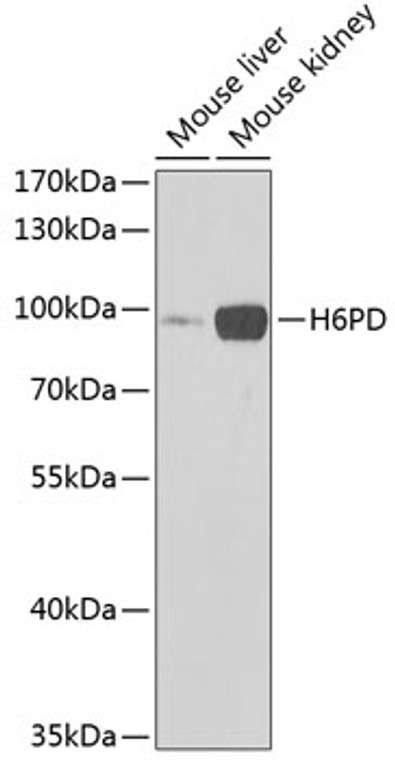| Host: |
Rabbit |
| Applications: |
WB |
| Reactivity: |
Human/Mouse/Rat |
| Note: |
STRICTLY FOR FURTHER SCIENTIFIC RESEARCH USE ONLY (RUO). MUST NOT TO BE USED IN DIAGNOSTIC OR THERAPEUTIC APPLICATIONS. |
| Short Description: |
Rabbit polyclonal antibody anti-H6PD (20-200) is suitable for use in Western Blot research applications. |
| Clonality: |
Polyclonal |
| Conjugation: |
Unconjugated |
| Isotype: |
IgG |
| Formulation: |
PBS with 0.02% Sodium Azide, 50% Glycerol, pH7.3. |
| Purification: |
Affinity purification |
| Dilution Range: |
WB 1:500-1:2000 |
| Storage Instruction: |
Store at-20°C for up to 1 year from the date of receipt, and avoid repeat freeze-thaw cycles. |
| Gene Symbol: |
H6PD |
| Gene ID: |
9563 |
| Uniprot ID: |
G6PE_HUMAN |
| Immunogen Region: |
20-200 |
| Immunogen: |
Recombinant fusion protein containing a sequence corresponding to amino acids 20-200 of human H6PD (NP_004276.2). |
| Immunogen Sequence: |
QELQGHVSIILLGATGDLAK KYLWQGLFQLYLDEAGRGHS FSFHGAALTAPKQGQELMAK ALESLSCPKDMAPSHCAEHK DQFLQLSQYRQLKTAEDYQA LNKDIEAQLQHAGLREAGRI FYFSVPPFAYEDIARNINSS CRPGPGAWLRVVLEKPFGHD HFSAQQLATELGTFFQEEEM Y |
| Tissue Specificity | Present in most tissues examined, strongest in liver. |
| Function | Bifunctional enzyme localized in the lumen of the endoplasmic reticulum that catalyzes the first two steps of the oxidative branch of the pentose phosphate pathway/shunt, an alternative to glycolysis and a major source of reducing power and metabolic intermediates for biosynthetic processes. Has a hexose-6-phosphate dehydrogenase activity, with broad substrate specificity compared to glucose-6-phosphate 1-dehydrogenase/G6PD, and catalyzes the first step of the pentose phosphate pathway. In addition, acts as a 6-phosphogluconolactonase and catalyzes the second step of the pentose phosphate pathway. May have a dehydrogenase activity for alternative substrates including glucosamine 6-phosphate and glucose 6-sulfate. The main function of this enzyme is to provide reducing equivalents such as NADPH to maintain the adequate levels of reductive cofactors in the oxidizing environment of the endoplasmic reticulum. By producing NADPH that is needed by reductases of the lumen of the endoplasmic reticulum like corticosteroid 11-beta-dehydrogenase isozyme 1/HSD11B1, indirectly regulates their activity. |
| Protein Name | Gdh/6pgl Endoplasmic Bifunctional Protein Includes - Hexose-6-Phosphate DehydrogenaseGlucose 1-DehydrogenaseGdhGlucose-6-Phosphate Dehydrogenase - 6-Phosphogluconolactonase6pgl |
| Cellular Localisation | Endoplasmic Reticulum Lumen |
| Alternative Antibody Names | Anti-Gdh/6pgl Endoplasmic Bifunctional Protein Includes - Hexose-6-Phosphate Dehydrogenase antibodyAnti-Glucose 1-Dehydrogenase antibodyAnti-Gdh antibodyAnti-Glucose-6-Phosphate Dehydrogenase - 6-Phosphogluconolactonase antibodyAnti-6pgl antibodyAnti-H6PD antibodyAnti-GDH antibody |
Information sourced from Uniprot.org
12 months for antibodies. 6 months for ELISA Kits. Please see website T&Cs for further guidance







